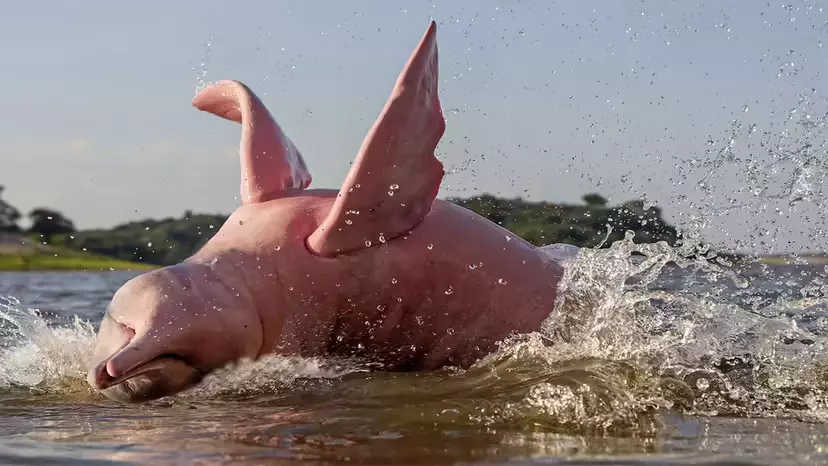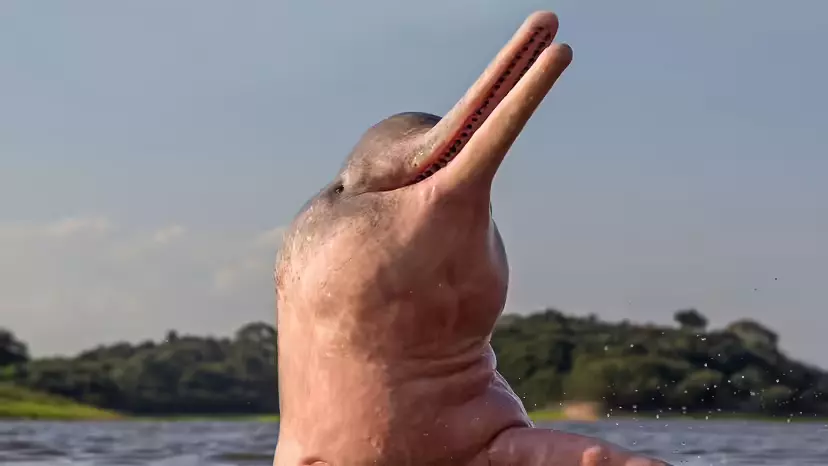Scientific name: Inia geoffrensis
Also called: Amazon river dolphin, boto, pink river dolphin
Size: Up to ~2.4 m (8 ft) and ~200+ kg (450 lb)
Range: Amazon–Orinoco basins (Brazil, Peru, Colombia, Ecuador, Venezuela, Bolivia, Guyana)
Ecological role: Large freshwater apex predator
Conservation: Internationally protected; facing dams, pollution, bycatch, vessel strikes, and habitat degradation

| Topic | Key Points |
|---|---|
| ID | Gray calves; some adults pink; no tall dorsal fin; flexible neck; mixed dentition |
| Range | Amazon–Orinoco basins (many countries) |
| Habitat | Main channels, oxbows, flooded forests; seasonally shifts with water level |
| Diet | Fish; also crabs and freshwater turtles |
| Threats | Dams, pollution (incl. mercury), bycatch, boats/noise, habitat loss |
| Conservation | Protect floodplains, gear change, pollution control, vessel rules, monitoring |
Born gray: Calves are gray; many adults—especially males—develop pink to rose coloring with age.
Likely drivers (multi-factor):
Vascular/skin factors: Rich capillary beds and thinner skin make blood flow more visible during activity or social interactions.
Scarring hypothesis: Repeated rubbing or minor scuffles can leave pink scar tissue that brightens with age.
Camouflage hypothesis: During flood season, some waters turn reddish/brown; a pinkish hue may reduce visibility in turbid water (still a hypothesis).
Sexual selection: In some areas, rosier males may be more attractive in courtship displays.

No tall dorsal fin: Instead, a low hump to slip between submerged branches.
Flexible neck: Unfused cervical vertebrae allow the head to turn side-to-side—perfect for weaving through flooded forest (varzea/igapó).
Teeth for variety: Conical gripping teeth at the front and more molar-like teeth behind for crushing crabs and river turtles.
Big, rounded pectoral fins: Precise maneuvering and quick braking in tight, obstacle-rich water.
Echolocation: Sophisticated sonar for low-visibility hunting.
Hydrologic rhythm: The basin pulses between low-water and flood seasons each year.
Flood season: Botos move into seasonally flooded forests to feed and raise young amid submerged roots and fruiting trees.
Low water: They shift back to main channels, oxbow lakes, and large tributaries.
Diet: Primarily fish, plus crabs and freshwater turtles; flexible foraging in complex, woody habitats.
Key threats
Dams & flow alteration: Block fish migrations, change current speeds, and disrupt floodplain timing critical to foraging and breeding.
Pollution (including artisanal gold mercury): Toxins bioaccumulate up the food web, affecting health and reproduction.
Bycatch & illegal take: Gillnets and longlines cause entanglement; in a few areas dolphins are still harmed or exploited.
Boats & noise: Collisions and underwater noise can interfere with echolocation and communication.
Habitat loss: Deforestation, shoreline hardening, and wetland infill shrink flooded-forest nurseries.
What helps
Basin-scale management of rivers–lakes–wetlands; safeguarding floodplain forests and travel corridors.
Better dam design/operations (environmental flows, fish passage) and robust impact screening.
Net-gear transition (no-gillnet zones, alternative gears) plus compensation and training for fishers.
Pollution control (especially mercury) and consistent water-quality monitoring.
Vessel measures: Speed limits and routing in hotspot channels; quieter engines where possible.
Science & monitoring: Acoustic surveys, photo-ID, standardized boat transects to track trends over time.
Bolivian river dolphin (Inia boliviensis) — Upper Bolivian Amazon; relatively isolated from botos by rapids; lower competition where it occurs.
Araguaia river dolphin (Inia araguaiaensis, “Araguaian boto”) — Araguaia–Tocantins system (Brazil); smaller, gray-pink, separated from I. geoffrensis by genetic evidence.
La Plata river dolphin / Franciscana (Pontoporia blainvillei) — The smallest of the group; inhabits coastal/estuarine waters along Brazil–Uruguay–Argentina; entirely gray, not pink.
Optical camouflage: Turbid, tea-stained water + mottled light reduce detectability (especially in flood season).
Structural complexity: Submerged forests and woody debris create a maze that masks movement.
Cautious behavior at low densities: In disturbed waters, individuals may avoid boats early.
Book licensed operators who follow distance/speed rules and never feed dolphins.
Choose low-noise, slow approaches; avoid tight channels with high speed.
Keep hands off; use long lenses and follow local drone rules.
Prioritize dawn/late-day outings with good visibility and minimal traffic.
Why are males pinker than females?
Likely a mix of age, blood flow/skin traits, and scarring; sexual selection could favor pinker males in displays.
What do they eat? Will they bite people?
Mostly fish, plus crabs and small turtles. They do not seek conflict with people; disturbance or harassment is what creates risk.
When/where are sightings best?
Flood season: edges of flooded forests, confluences, and quiet creeks.
Low water: main channels, oxbows, and large lakes with slower flow.
How do they turn their heads?
Botos have unfused neck vertebrae, allowing lateral head movement uncommon in marine dolphins.
animal tags: boto
We created this article in conjunction with AI technology, then made sure it was fact-checked and edited by a Animals Top editor.